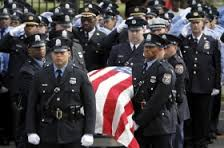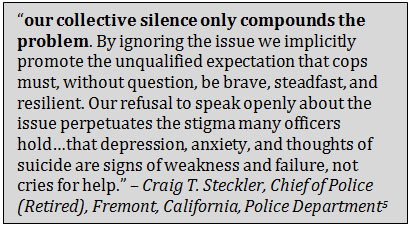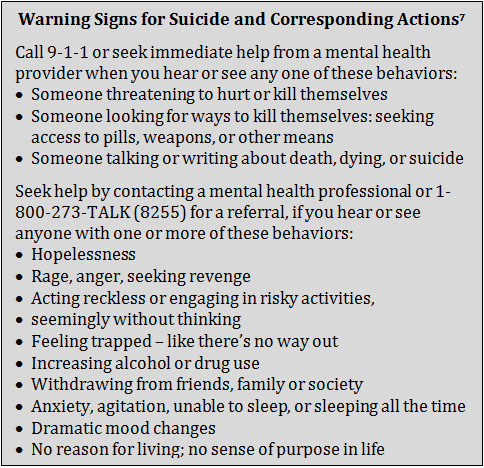what can be done to help reduce police suicide, stress, and substance abuse?
Preventing Constabulary Enforcement Officer Suicide
 Suicide is a significant public health problem that touches people from all backgrounds. The statistics are staggering: In 2010, more than than 38,000 people died past suicide;1 and in 2011, more than ane million adults reported making a suicide endeavour and more than than 8 meg adults seriously thought near attempting suicide.2 The impact of suicide is far-reaching emotionally and economically, affecting families, friends, coworkers, and many others.
Suicide is a significant public health problem that touches people from all backgrounds. The statistics are staggering: In 2010, more than than 38,000 people died past suicide;1 and in 2011, more than ane million adults reported making a suicide endeavour and more than than 8 meg adults seriously thought near attempting suicide.2 The impact of suicide is far-reaching emotionally and economically, affecting families, friends, coworkers, and many others.
Each yr, more law enforcement officers dice past suicide than are killed in the line of duty.3 Officers are at a heightened risk for suicide, due to experiencing such risk factors as exposure to violence, suicide, or other job-related stressors; low, anxiety, or other mental affliction; substance abuse; domestic abuse; admission to means to kill oneself (e.g., firearms); and poor physical health.4
Withal, there is a positive side to this story: Suicide is preventable—in that location is a growing will for suicide to be addressed; we accept strategies and tools for suicide prevention—and if you are struggling with thoughts of suicide, there is help and promise. Below are ways yous can help others or discover assistance for you.
Everyone has a role in suicide prevention
The stakes of inaction are far too high when information technology comes to suicide. Consequences of suicidal beliefs can include mental and emotional suffering, unproductive or absent staff, injury or disability, or fifty-fifty expiry, all of which can accept a significant toll on constabulary enforcement agencies, families, and communities.
 It is imperative that police enforcement agencies take action to prevent suicide and promote mental wellness. Treat officers' mental and emotional health should be on par with that for their rubber and physical health. In order for prevention efforts to be successful, agencies must also address cultural and environmental barriers to prevention at all levels, e.grand., the notwithstanding-pervasive stigma that discourages at-risk officers from seeking aid for fright of negative peer reactions or career ramifications; lack of comprehensive suicide prevention policies; and insufficient training for officers or health care providers.
It is imperative that police enforcement agencies take action to prevent suicide and promote mental wellness. Treat officers' mental and emotional health should be on par with that for their rubber and physical health. In order for prevention efforts to be successful, agencies must also address cultural and environmental barriers to prevention at all levels, e.grand., the notwithstanding-pervasive stigma that discourages at-risk officers from seeking aid for fright of negative peer reactions or career ramifications; lack of comprehensive suicide prevention policies; and insufficient training for officers or health care providers.
At that place are many people who have a role to play in preventing suicide amidst law enforcement officers. The attitudes and behaviors of chiefs, supervisors, peers, wellness care providers, family, friends, faith leaders, and others can all influence officers' health.
The National Strategy for Suicide Prevention 6 (NSSP) outlines different roles people can play to prevent suicide. In police enforcement agencies, these roles tin vary. For case: By prioritizing suicide prevention and enacting changes in bureau-wide policies and practices, a chief can influence the culture change necessary for constructive prevention efforts. Past learning how to recognize and respond to warning signs for suicide, supervisors, peers, family members, and others can back up at-adventure officers and encourage them to seek the assistance they need. By effectively assessing and managing officers' suicide risk, health care providers can reduce risk and support resiliency and recovery. By engaging wellness care providers, peers, and families and enhancing policies and practices, agency leaders can more effectively respond after a suicide attempt or death.
One claiming for law enforcement agencies is a lack of access to advisory resources to help address suicide. To assist agencies adopt a comprehensive approach to suicide prevention and response, the International Clan of Chiefs of Police (IACP), Bureau of Justice Assistance, U.South. Section of Justice, and EEI Communications compiled resources from agencies beyond the country that are available on IACP's Center for Officer Prophylactic and Wellness website. Other resources are provided in "The Function of Police Enforcement Officers in Preventing Suicide," a customized information folio adult past the Suicide Prevention Resources Eye.
Seeking and providing assist
Another challenge comes from agencies being unprepared to support officers who are struggling, or officers existence unaware of how to seek help for themselves. If you are struggling with thoughts of suicide, it's okay to seek aid, which is a sign of strength, not weakness. Many people with like struggles have been able to discover promise, exist resilient, and demonstrate that recovery is possible. Talk with a family fellow member; a peer; your supervisor; your agency leadership; an EAP representative; a healthcare provider; the confidential National Suicide Prevention Lifeline (1-800-273-8255); or Safety Call Now (1-206-459-3020), which is a crisis line for public prophylactic employees, to get the back up and treatment you deserve.
 If y'all know someone at risk of suicide, there are steps yous tin take to assist them in getting help. If you know the alert signs of suicide, can propose available referral and treatment options, and tin provide social support, y'all will be better able to help an officer establish a stronger will to go on living and ultimately pull through. Below are trainings that can teach you how to recognize and respond to the signs of suicide risk:
If y'all know someone at risk of suicide, there are steps yous tin take to assist them in getting help. If you know the alert signs of suicide, can propose available referral and treatment options, and tin provide social support, y'all will be better able to help an officer establish a stronger will to go on living and ultimately pull through. Below are trainings that can teach you how to recognize and respond to the signs of suicide risk:
- In Harm'due south Way: Constabulary Enforcement Suicide Prevention 8 � This is a train-the-trainers plan that prepares attendees to train administrators, officers, and staff on: recognizing and responding to suicide hazard; reducing stigma around assistance-seeking beliefs; and developing policies, protocols, and procedures to address at-take chances officers.
- Question, Persuade, Refer (QPR) for Law Enforcement9 � This is an online certificate program that teaches police force enforcement professionals how to recognize and respond to suicide risk. The program also includes advanced coursework that covers suicide take a chance assessment and direction.
Moving forwards
At that place are several recent and forthcoming advancements that tin can assist y'all carry out this important work. The IACP, with support from the COPS Role, has but issued a report on police force enforcement suicide and mental health that will serve as a national strategy for the prevention of suicide amongst law enforcement officers. Agencies tin use this strategy to affect civilisation change and comprehensively address suicide prevention, intervention, and aftercare. The National Activity Brotherhood for Suicide Prevention (Activeness Alliance), the public-private partnership advancing the NSSP, has released a video on police force enforcement officeholder suicide, featuring police enforcement professionals of all ranks who are committed to this important piece of work. The Action Brotherhood has also launched a framework to help the public communicate more successfully well-nigh suicide and suicide prevention—by focusing messaging on social back up, treatment, hope, resilience, and recovery—to assist transform attitudes, behavior, and cultural norms.
At the Action Alliance, our vision is a nation complimentary from suicide. I encourage yous to share in this vision, to make suicide prevention a high priority in your bureau and your community, to support colleagues in need, and to enquire for help when needed. Together, we tin save lives.
Katherine Deal, MPH
Deputy Secretary
National Action Alliance for Suicide Prevention
References
1 Centers for Disease Control and Prevention, National Center on Injury Prevention and Control. "Injury Prevention and Control: Data and Statistics." http://www.cdc.gov/injury/wisqars/fatal.html.
ii Substance Abuse and Mental Wellness Services Administration. 2012. Results from the 2011 National Survey on Drug Utilize and Health: Mental Health Findings. Washington DC: U.S. Department of Health and Man Services. http://www.samhsa.gov/data/NSDUH/2k11MH_FindingsandDetTables/2K11MHFR/NSDUHmhfr2011.htm#2.3.
three International Association of Chiefs of Police. "Preventing law enforcement officeholder suicide." http://www.theiacp.org/Preventing-police-Enforcement-officer-suicide.
4 Hackett, Dell P., and John One thousand. Violanti. 2003. Police suicide: Tactics for prevention. Springfield, IL: Charles C Thomas Pub Ltd.
5 Steckler, Craig T. 2013. "IACP: Breaking the Silence on Law Enforcement Suicides," President's Message, featured in The Constabulary Chief. 80 (July): 6. http://www.policechiefmagazine.org/magazine/index.cfm?fuseaction=display_arch&article_id=2963&issue_id=72013.
6 Function of the Surgeon Full general and National Action Alliance for Suicide Prevention. 2012. 2012 National Strategy for Suicide Prevention: Goals and Objectives for Action. Washington, DC: U.S. Section of Health and Human Services, September. http://actionallianceforsuicideprevention.org/NSSP.
7 Suicide Prevention Resources Center. "Best Practices Registry for Suicide Prevention: Alarm signs for suicide prevention." Starting time posted May 4, 2007. http://www.sprc.org/bpr/department-II/warning-signs-suicide-prevention.
8 Suicide Prevention Resource Center. "Best Practices Registry for Suicide Prevention. In Harm'due south Way: Law Enforcement Suicide Prevention." First posted April 9, 2012. http://www.sprc.org/bpr/section-3/impairment%E2%lxxx%99s-fashion-police-enforcement-suicide-prevention.
ix Suicide Prevention Resource Center. "Best Practices Registry for Suicide Prevention. Question, Persuade, Refer (QPR) for Constabulary Enforcement." Beginning posted on May 14, 2012. http://world wide web.sprc.org/bpr/department-III/question-persuade-refer-qpr-police-enforcement.
Dorsum to top
Public Health Approaches for Law Enforcement | Boston Public Wellness Committee | New Written report for Sexual practice Trafficking Investigators | Preventing Officer Suicide | 2014 Sutin Accolade Nominations | CHP Now Open | CPD and CRI-TA Now Open up | MYVP Initiative Announced | National Middle for Edifice Community Trust | Medal of Valor Nominations
Source: https://cops.usdoj.gov/html/dispatch/06-2014/preventing_officer_suicide.asp
0 Response to "what can be done to help reduce police suicide, stress, and substance abuse?"
Post a Comment